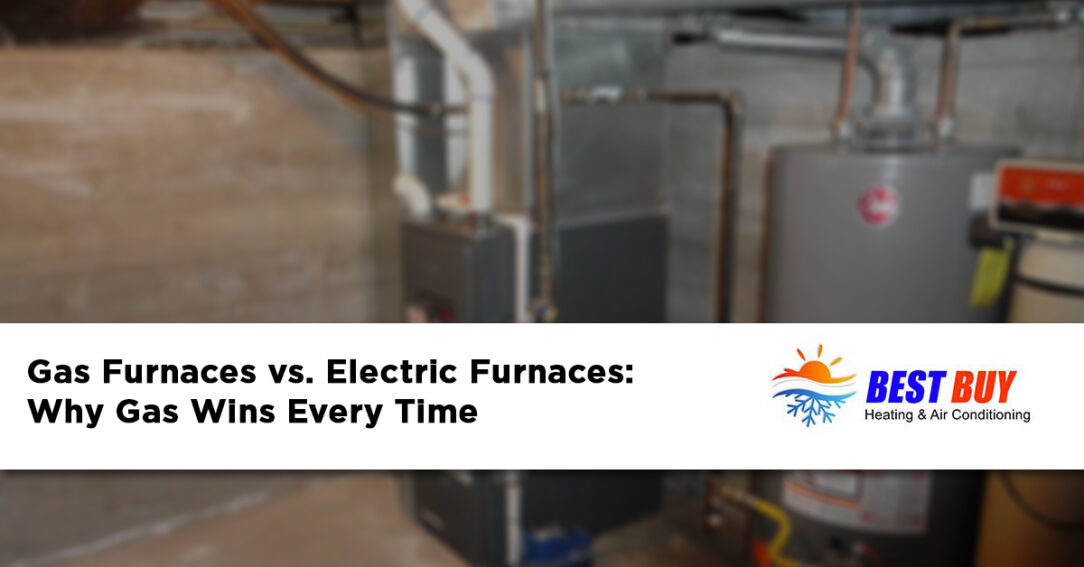Energy efficiency is a big topic these days.
As you’d suspect, we’ve discussed it plenty here on the Best Buy Heating and Air blog, like our guide to energy efficient air conditioning for the Northern Colorado area, or our frequent posts about DIY maintenance tips for your HVAC system, many of which are concerning ways to increase your energy efficiency. Just last month, our focus was on the energy efficiency rebates offered by Atmos Energy for Greeley residents.
Needless to say, it’s a big conversation. Energy efficiency isn’t just about saving the environment—it also plays a big part in saving your wallet. Having a great furnace—and following some basic maintenance steps—can reduce the amount you’re spending on energy to stay warm in the winter.
We sometimes have customers ask us which is better: an electric furnace or a gas furnace?
Most home and business heating in Northern Colorado is powered by gas, unless you’ve upgraded to geothermal heating (which is another story entirely and beyond the scope of this post, but you can read about it more in our posts Understanding Heat Pumps: Efficient Year-Round Heating and Cooling and Why Geothermal HVAC Systems Hardly Need Any Maintenance for Up to 55 Years.)
Even though electric furnaces are often less expensive to install, in the long run they’ll cost you way more. In today’s post we’ll break down exactly why that is.
Electric Furnaces Are Cheaper… At First

Electric furnaces do have one plus: they’re cheaper to install than a gas furnace, on average. The problem is that they ultimately end up costing more in the not-so-long-run—but we’ll get into that in a moment.
The average electric furnace might cost a homeowner somewhere between two and four thousand dollars to purchase and install. Comparatively, a gas furnace might run around four to six thousand dollars for purchase and install. Electric furnaces typically have a longer lifespan when compared to gas furnaces too, with the latter usually functioning for about 20 years and the former getting about 30 years.
This, unfortunately, is where the savings end. In most parts of the United States, electricity is much more expensive than natural gas (and this is certainly the case in Colorado, even during our typically cold winters when the price of natural gas rises). Even if you were to factor in the longer operational lifespan of an electric furnace, the gas furnace will still come out on top.
In terms of the technology used, electric furnaces have come a long way since they originally hit the market. However, they’re really only a viable choice in the event that you, for whatever reason, happen to live in an area where natural gas is cheaper than electricity (highly uncommon, and practically unheard of in this part of the country), or you live somewhere that simply cannot receive natural gas—and that’s equally uncommon.
Typically, a Gas Furnace Will Produce More Heat in a Larger Area
Another drawback of an electric heater is that these devices, while easier to maintain than a gas furnace and typically quieter, just cannot put out the same amount of heat in the average home when compared to a gas furnace.
Since an electric furnace produces less heat efficiency, the owner is likely to run it even more often, thus compounding the energy cost problem even further. In larger homes or businesses, multiple units may even be required.
Learn More About Energy Efficient Heating in Northern Colorado From Best Buy Heating And Air’s Professional Team

There are many ways to heat your home, but if you’re faced with the choice between a gas furnace and an electric furnace, the gas furnace is going to almost always be the more economical, energy efficient choice.
If you’re looking for ways to increase your energy efficiency and reduce your monthly power bill, there are two very effective steps you can take:
- Get your HVAC system an annual maintenance appointment with us. Our post The Real Benefit of HVAC Maintenance is in the Numbers: How to Save Thousands will break down for you how proper maintenance is one of the easiest, most affordable ways to cut your energy costs and get better performance out of your HVAC system.
- Install a programmable thermostat. Depending on your location, you may even be able to get a substantial rebate for the unit. On average, programmable thermostats save homeowners around 10% on their power bill annually.
If you’d like to learn more about increasing your energy efficiency and the heat or cooling capability of your HVAC system, please feel to contact us today.
